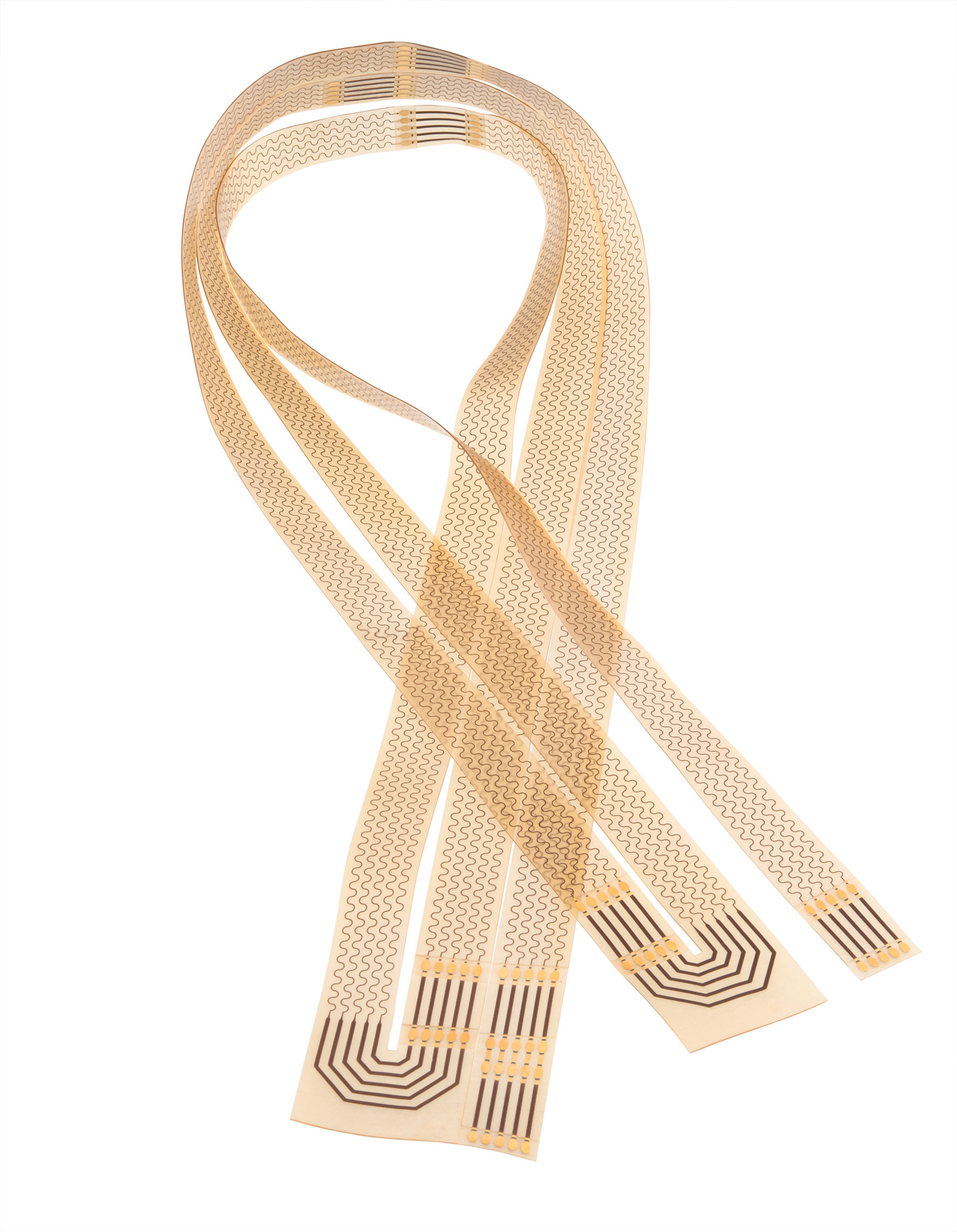
flexible and stretchable web substrates
practically ‘endless’ electronics with integrated components

highly reliable chip interconnects

can be rolled into housings like a cable or used flat
In healthcare, miniaturisation and flexible electronics have brought valuable benefits. Minimally invasive procedures offer a way to investigate or treat many conditions without major surgery. But despite the sophistication of devices such as smart catheters, they still rely on ‘old fashioned’ wiring to connect the numerous electrical (and sometimes optical) fibres to the rigid tip of the device. The wiring is done by hand and can represent up to 80% of the product cost. It also affects reliability, manufacturing yields, weight and use of resources.
A flexible, thin stripe with the various hybrid electronic components integrated on it could avoid these connection problems. The stripe could also be manufactured long enough for other healthcare applications such as monitoring that may require cables of up to two metres or more.
Similarly, long, flexible stripes would enable new applications in LED lighting. For instance, it would be possible to create large, flat light surfaces that could be fully integrated in the glazing of buildings and ultimately mimic natural light. New manufacturing techniques could also cut the amount of copper used (reducing thicknesses from as much as 35 µm to 1 µm). This would further add to the versatility and sustainability of LED solutions which already offer major savings in energy and CO2 emissions.
Currently, microelectronic system integration is done either on rigid boards or flexible films each with a limited size, typically about 60 cm x 40 cm. By enabling R2R processing and electronics integration on very long flexible substrates, HyPerStripes will overcome these limitations. It will allow manufacture of cost-effective, high-performance stripes that can be rolled into housings like a cable or used flat.
This will directly address requirements for next generation medical instruments and LED lighting. And many more applications could benefit as well: from health monitoring, secure electronics (e.g. seals that prevent tampering with goods in shipment) and condition monitoring in industrial infrastructures to automotive.
Europe already has R&D knowledge in this domain, so a key goal for HyPerStripes is to transfer this know how to industrial production. It will do this via an open sustainable technology platform that will offer printing technologies and lithographically patterned copper wiring systems and low temperature assembly steps – all in a single one-stop consulting and manufacturing platform.
Other deliverables will be:
• Roll-to-roll processing on flexible and stretchable web substrates that allows for practically ‘endless’ electronics with integrated components
• Design and simulation procedures for flexible systems which include a focus on sustainability and reliability
• Highly reliable chip interconnects for bare die integration at low temperatures based on nanostructures and innovative soldering technologies (to create electrical interconnects on heat-sensitive substrate materials such as polyurethanes)
• Digital algorithms for lithographic patterning and auto-correction of dimensional distortions in flexible and stretchable film substrates.
Importantly, the HyPerStripes technologies will be generally applicable, independent of the specific requirements of the use case. This means, for instance, the long stripes for medical endoscopes could be manufactured on the same technology platform as LED surfaces.
HyPerStripes brings together academic, RTO and industry players including major international companies and SMEs. Together, they cover the entire value chain including R2R equipment manufacturing, materials and process technologies, design and simulation tools, technology providers, research expertise and infrastructure, as well as flexible electronic systems production and manufacture of products for end-markets. This wide-ranging cooperation creates synergies and will ensure a leading position for European industry in flexible and stretchable systems. Plus, several partners will be able to move rapidly into mass production of foil-based systems and stretchable substrates with embedded devices.
The HyPerStripes project will bring many benefits for European industry, employment and socially valuable applications. It will enable European companies to maintain their leadership in specific healthcare and lighting applications. It will also create an ecosystem that allows European companies to compete globally in the domain of R2R printed circuit board (PCB) production. Currently dominated by Asian manufacturers, the global flexible PCB market is expected to reach a CAGR of 11.9% during the period 2019-2027 .
In healthcare, European companies will be able to reinforce their leadership in areas such as smart catheters through lower costs and higher performance. And they can extend these advantages to new areas such as smart implants. Demand for such applications is being driven by aging populations, the rise of chronic diseases and the risk of further pandemics, all creating the need for innovative and cost-saving therapies. Indeed, the market for minimally invasive surgical instruments alone is expected to grow from USD 20 billion in 2019 to USD 33 billion in 2025.
Likewise, the LED light market is expected to see strong growth. Valued at EUR 63 billion in 2020 it is expected to reach USD 132 billion by 2026 at a CAGR of 14.25% over the forecast period 2021 – 2026. This will have an important impact for sustainability leading to a reduction of 160 million metric tons of CO2 emissions. Hyperstripes will further add to these ‘green’ benefits by cutting the amount of copper and plastic used in manufacturing.
More widely, HyPerStripes will position Europe to be a global leader in the young and dynamic market of flexible hybrid electronics. By building an ecosystem for flexible electronics ‘Made in Europe’ that inherently incorporate sustainability concerns, the project will bring the advantages of lightweight, compact and cost-effective electronics to a host of current and future applications.
